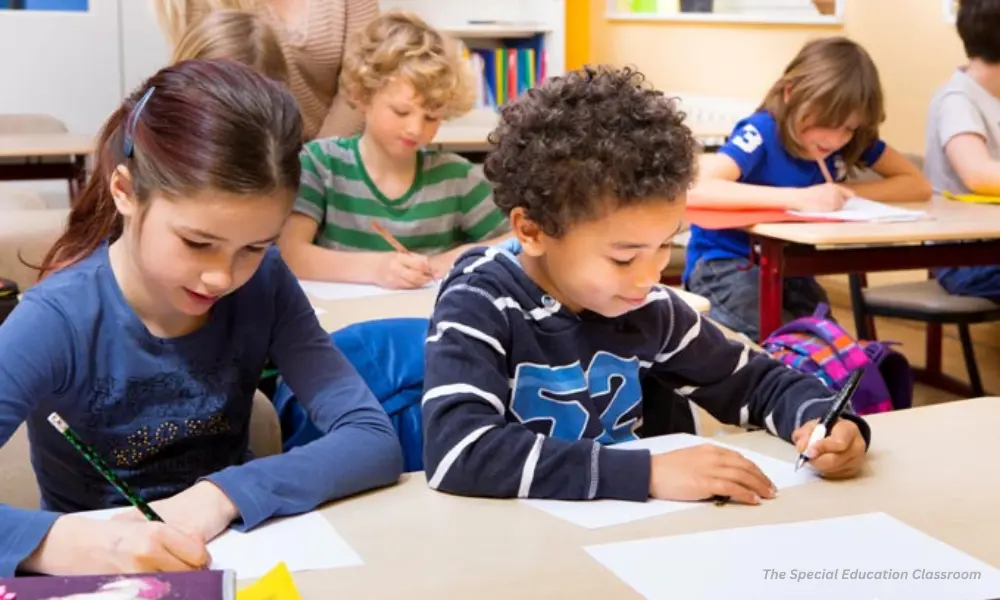The Special Education Classroom: A Comprehensive Guide to Empowering Every Learner

Classroom Environment and Setup
Sensory-Friendly Design
The Special education classroom are often equipped with dimmable lights, quiet corners, and minimal distractions. This helps create a calming space for students who are sensitive to their environment.
Table of Contents
Behavior Management Plans
Each student may have a personalized behavior plan. These plans include clear expectations, routines, and rewards to encourage positive behavior.
Safe Spaces and Calming Corners
Many rooms include calming areas with beanbags, sensory bottles, or weighted blankets to help students self-regulate during emotional or sensory overloads.
Strategies That Work in Special Education
Positive Reinforcement
Praise, reward systems, sticker charts—you name it. Positive reinforcement is a cornerstone of special education teaching strategies.
Visual Schedules
Daily routines are displayed visually so students can follow along and feel secure. This helps reduce anxiety and promotes independence.
Multisensory Learning
Instead of just reading or listening, students might touch, build, move, or explore through different senses. This approach increases engagement and comprehension.
Challenges in Special Education Classrooms
Lack of Resources
Many schools struggle with underfunding. Limited resources can make it difficult to provide all the support students need.
Teacher Burnout
Special education teachers often juggle high emotional and administrative loads. Support and self-care are essential for teacher longevity.
Misunderstandings and Stereotypes
Some still view special ed as a “less than” option, but in reality, it’s a life-changing support system. Awareness and education help break the stigma.
Family and Community Engagement
Parent Collaboration
Parents are key players in the IEP process. Regular communication between home and school leads to better outcomes for students.
Community Resources
Local services such as therapy clinics, non-profits, and support groups can provide additional help and networking opportunities.
Advocacy Groups
Organizations like Wrightslaw, The Arc, and Parent Training Centers empower families to advocate for their child’s rights and needs.
Success Stories
Real-Life Classroom Wins
From a non-verbal child saying their first word to a student mastering independent living skills—special education classrooms are full of small (and big) victories.
Student Achievements
Many students transition successfully into mainstream classes, graduate, and even go on to college or employment.
Long-Term Impact
Special education doesn’t just prepare students for tests—it prepares them for life. Confidence, self-advocacy, and independence are long-term outcomes.
Future of Special Education
Innovations in Teaching
Technology like AI tutors, VR learning environments, and adaptive software is making learning more personalized and accessible than ever.
Policy Changes
Policies are evolving to better support inclusion, teacher training, and early intervention, paving the way for more equitable education.
Inclusive Education Goals
The ultimate aim? A world where every classroom is equipped to meet the needs of all learners—regardless of ability.
Conclusion
Special education classrooms are not just about teaching—they’re about believing in every student’s potential. These classrooms provide structure, support, and compassion for kids who need it most. Whether it’s through a custom learning plan, one-on-one support, or assistive tech, every element is designed to help students succeed at their own pace.
If you or someone you know is navigating the world of special education, remember: you’re not alone. These classrooms are built with care, backed by law, and led by people who are passionate about making a difference. That’s not just special—it’s essential.
FAQs About Special Education Classrooms
What qualifies a student for special education?
A student qualifies if they have a diagnosed disability that affects their ability to learn in a general education setting, and they require specialized instruction to progress.
Can students move from a special education classroom to a regular one?
Yes! Many students transition to general education as they grow and develop skills. Inclusion is a common goal when it’s appropriate.
What’s the difference between an IEP and a 504 Plan?
An IEP provides specialized instruction and services, while a 504 Plan offers accommodations without changing the curriculum.
Are all special education classrooms the same?
Not at all. Some are self-contained, while others are resource rooms or inclusive settings. The structure depends on student needs.
How can parents support their child in a special education setting?
Stay involved in IEP meetings, communicate with teachers regularly, and advocate for your child’s needs. Partnership is key to success.






